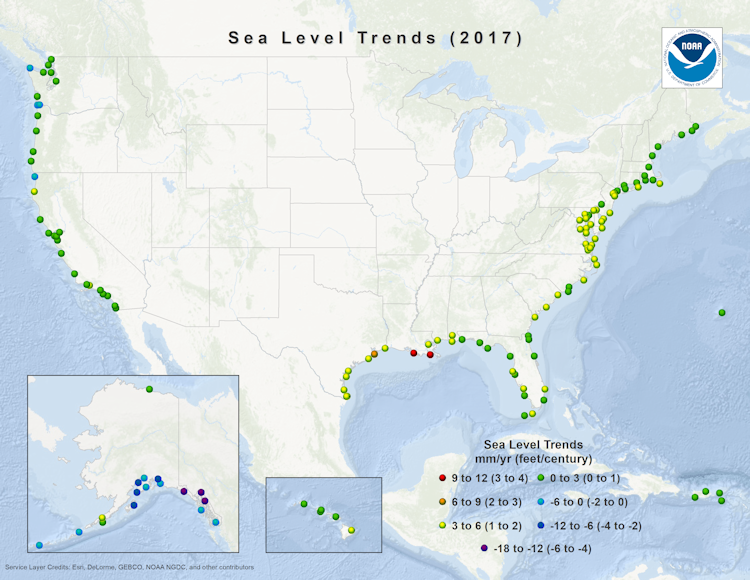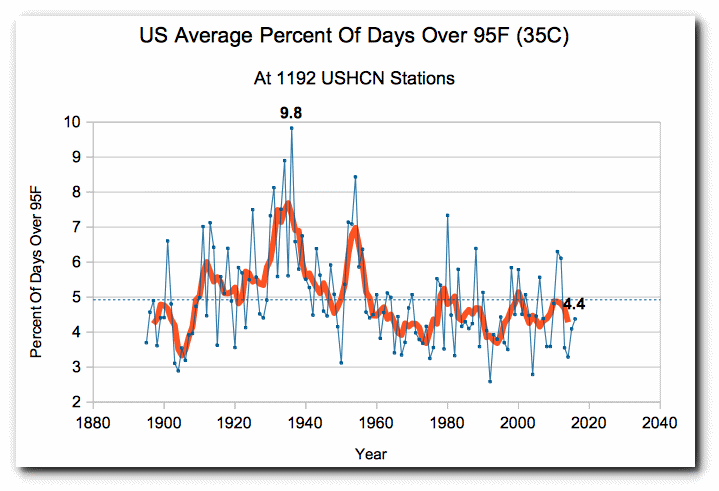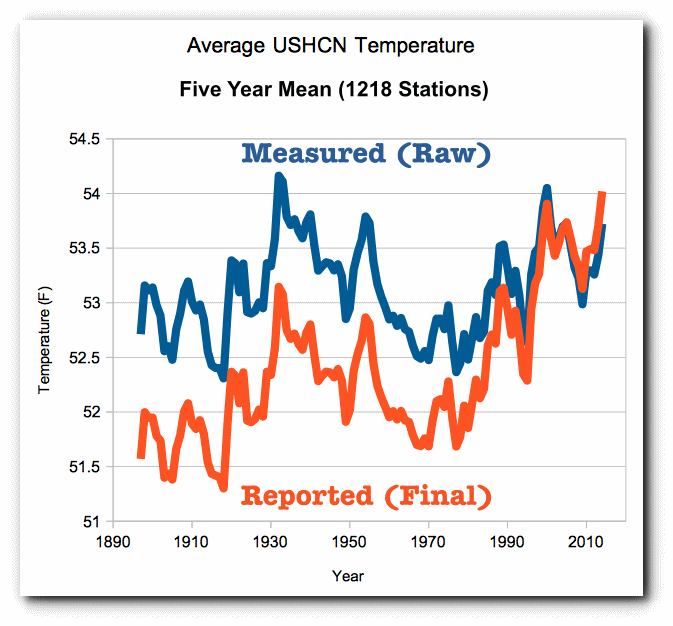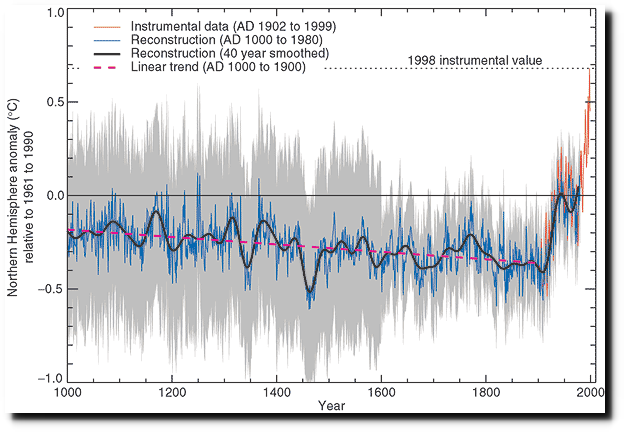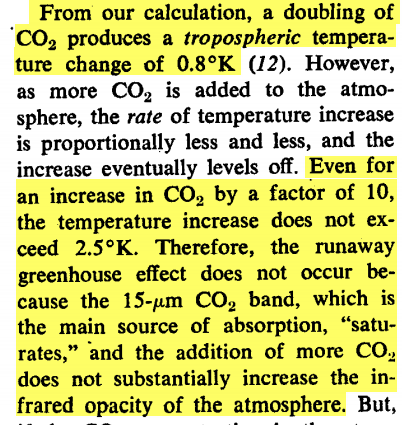So far, we've looked at the worst case scenario addressed in the IPCC reports and seen that, at this point in time, the predicted means for that and the "best case" scenario are almost indistinguishable. We've also seen that, according the United States Governments most recent assessment, global temperatures are above the current prediction for the worst case scenario. That the mean for the worst-case scenario reaches about 8F over preindustrial temperatures in 2100.
What we haven't seen as any indication of how likely this worst-case scenario is. For that we need to look at the IPCC's latest Annual Assessment Report. But first, by way of background, let's take a minute to talk about what the IPCC is and how it came about. Before 1975, climate was not really studied as a discrete area of research. Lots of people studied things that affected the climate, but from different perspectives. Some scientists looked at greenhouse gases concentrations, and wrote about the potential for warming. Some wrote about increased emission of aerosols and the potential for cooling. Ditto for scientists that studied the orbital cycles of the earth and paleoclimate information, and noted that we were headed for another ice age. All of these different groups of scientists with their study of different forcings of the climate is the origin of the trope about a "global cooling scare" in the 1970s.
https://arstechnica.com/science/2016/06 ... g-ice-age/In 1975, the National Academy of Sciences issued a report on the state of science regarding the climate. It noted that there was currently no reliable means of predicting future climate, that warming from CO2 was likely to have a larger influence that aerosols, and that there was some "finite chance" that the earth would experience an ice age at some point in the future. The NAS, made a number of recommendations that boil down to "let's do some science and get a handle on this."
http://scienceblogs.com/stoat/2011/07/1 ... academy-o/In 1979, an NAS panel concluded that the planet was warming, not cooling.
https://history.aip.org/climate/GCM.htm#L_M013 It also put a number on the likely effect of a doubling of CO2 in the atmosphere: A range of 1.5-4.5C, with a mean value of 3C.
https://history.aip.org/climate/GCM.htm#L_M013That same year, 300 scientists from around the world met at a World Climate Conference in Geneva, under the auspices of the World Meteorological Organization and the International Council for Science. They reached a consensus that continued expansion of human activities -- especially CO2 emissions -- may cause significant regional and global changes in climate. They also predicted that increased temperatures from global warming would be detectable at the end of the century. As with the NAS, the main recommendation was "do some science."
https://history.aip.org/climate/internat.htm#L_M003By 1998, there was a growing sense that governments should at least consider addressing greenhouse growth. The Bush administration, however, didn't trust the informal groups of scientists that were producing the research.
The U.S. government therefore recommended to international agencies the creation of some kind of new "intergovernmental mechanism." Other governments fell in line, and an Intergovernmental Panel on Climate Change was established in 1988
The IPCC is an agency of the United Nations.
https://history.aip.org/climate/Govt.htm#L_M005http://blogs.edf.org/climate411/2007/11 ... eginnings/The IPCC issues periodic Assessment Reports. The first was issued in 1990. The most recent was issued in 2014. The next is due in 2022. The ARs function as literature reviews of the state of climate science. They include include predictions of future temperature, sea level rise, ocean acidity, extreme temperatures, etc. They also predict the consequences of the predicted changes on thinks like food supply and flooding on both a global and a regional basis. Because they extensively survey the relevant scientific literature, the ARs are the best place to start when looking for any information about what the science says.
The AR reports are divided into sections, each produced by a working group of scientists. Working Group 1 is responsible for assessing the science and presenting the general future predictions of the Global Climate Models. Each Working Group report begins with a "Summary for Policymakers." Although the report itself is written by the scientists, the Summaries are written by political folks, with input from the scientists. So, keep in mind, that when you read the SPM, you're looking at the science filtered through a UN committee.
The SPM's highlight their conclusions on each point, followed by some explanatory detail. Here's the SPM's highlighted conclusion on future predictions of warming.
Global surface temperature change for the end of the 21st century is likely to exceed 1.5°C relative to 1850 to 1900 for all RCP scenarios except RCP2.6. It is likely to exceed 2°C for RCP6.0 and RCP8.5, and more likely than not to exceed 2°C for RCP4.5. Warming will continue beyond 2100 under all RCP scenarios except RCP2.6. Warming will continue to exhibit interannual-to-decadal variability and will not be regionally uniform (see Figures SPM.7 and SPM.8). {11.3, 12.3, 12.4, 14.8}
The AR 5 defines certain terms as representing probabilities.
In this Summary for Policymakers, the following terms have been used to indicate the assessed likelihood of an outcome or a result: virtually certain 99–100% probability, very likely 90–100%, likely 66–100%, about as likely as not 33–66%, unlikely 0–33%, very unlikely 0–10%, exceptionally unlikely 0–1%. Additional terms (extremely likely: 95–100%, more likely than not >50–100%, and extremely unlikely 0–5%) may also be used when appropriate. Assessed likelihood is typeset in italics, e.g., very likely (see Chapter 1 and Box TS.1 for more details).
So, here's what the conclusion says about our worst-case scenario, RCP 8.5:
Under RCP 8.5, there is a 66-100% chance of exceeding 2C in 2100.
That's it. If you are a policymaker and you are relying on the reports conclusions as expressed in the numbered and highlighted conclusions, there is no information about how likely it is that temperatures will exceed 4C by 2100, which is what RCP 8.5 predicts. Contrary to claims by deniers, the "political" part of the report doesn't hysterically report the worst case -- it avoids talking about it.
Now, there is a prediction for the worst case, if you drop down into the details below the summary conclusion:
Relative to the average from year 1850 to 1900, global surface temperature change by the end of the 21st century is projected to likely exceed 1.5°C for RCP4.5, RCP6.0 and RCP8.5 (high confidence). Warming is likely to exceed 2°C for RCP6.0 and RCP8.5 (high confidence), more likely than not to exceed 2°C for RCP4.5 (high confidence), but unlikely to exceed 2°C for RCP2.6 (medium confidence). Warming is unlikely to exceed 4°C for RCP2.6, RCP4.5 and RCP6.0 (high confidence) and is about as likely as not to exceed 4°C for RCP8.5 (medium confidence). {12.4}
The first two sentences basically repeat what is in the highlighted conclusion. The bolded sentence is new. Translated it says:
Under even the best case scenario there is a 0-33% chance of exceeding 4C in 2100.
Under the worst case scenario, the chance of exceeding 4C is 33-66%
Restated, under the worst case scenario, the chance of exceeding 4C is a coin flip. Yep, that's the "alarmist" IPCC. The worst case it evaluates is RCP 8.5, with a coin flip chance of reaching 4C in 2100. But, as we go through the report, we'll not find much discussion about that 4C number, let alone the top end of the RCP 8.5 range. There is little, if any, discussion of what is expected to happen at 5C or 6C or the probability of reaching those temperatures.
“The ideal subject of totalitarian rule is not the convinced Nazi or the dedicated communist, but people for whom the distinction between fact and fiction, true and false, no longer exists.”
― Hannah Arendt, The Origins of Totalitarianism, 1951
